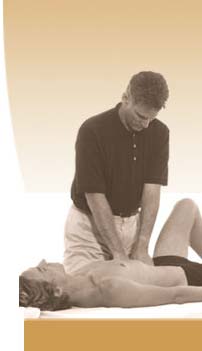
Courses
& Class Schedule
Upper Body
We know that the body holds tension and repressed emotion. Many of us, however, do not know what specific tissues are responsible for this occurrence.
In this workshop you will learn to identify, manipulate, and release myofascial tissue that holds chronic, painful, and exhausting stress and tension.
By the end of the workshop you will know how to release this unwanted stress in the chest, neck, shoulders, hands, back and waist, in other words, over the whole upper body.
![]()
In addition, you will gain an understanding of the relationship between posture and emotional attitudes and how constricted myofascial tissue leads to creating and reinforcing emotional negativity.
The strokes will be taught in sequence so that once learned you will be able to give a Myofascial Release Massage for the upper body.
Imagine how you will feel at the end of the workshop! Your hands will become supple and strong, your neck and shoulders will relax, your chest will be more open, you will naturally breathe more deeply with less effort, and your back and waist will be more flexible.
![]()
Imagine how your clients will feel after you have mastered these techniques.
This workshop, taken with the Myofascial Release Massage Part II, Lower Body, will enable you to offer a complete head to toe Myofascial Release Massage as well as work on specific problem areas. The hand, neck, and shoulder work is suitable for on-site application as well as clinical practice. We will discuss the conditions and occupations that will benefit most from this work. Contra-indications will also be noted.
(Please note: Bring sheets, towel, and oil. Women should wear a bra or bikini top.)
![]()
About the Manuals
As part of the seminar you will receive a 68 page, fully illustrated manual (sample page) that includes a summary of all the key points discussed in class.
A separate manual was created for each of the three courses. The manuals are written as a guide to perform each stroke taught in class.
The manuals are especially useful for three reasons. First, each stroke is illustrated with two kinds of pictures; a profile picture showing the relationship of the practitioner's body to the client's body as the stroke is being performed and two, a picture of what the stroke should look like from the practitioner's own eyes.
Second, the description of each stroke is easy to follow because it is divided into the following sections; the tool (body part) the practitioner used, where the practitioner stands in relationship to the client, the client's position, the direction of the stroke, a description of the stroke, any client movement, and tips which will make the stroke more effective.
Lastly, most of the conceptual material discussed in class is also written about in the manuals so that students do not have to take extensive notes in the class and still have the material available for study outside the classroom.
-- More about Courses & Certification --
II. Lower Body
III. Advanced Strokes
IV. Introductory Course
V. Certification
VI. Instructors

"I really enjoyed both weekend classes and couldn't believe how the time flew by.
"The strokes and techniques you taught us are wonderful and so effective.
"My clients are appreciating my new found talents and I am almost becoming famous in my community."
Wanda Boorky
MT
Pomrmet Center, CT